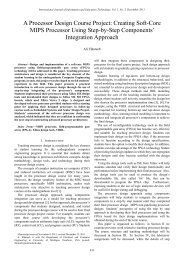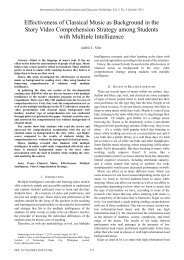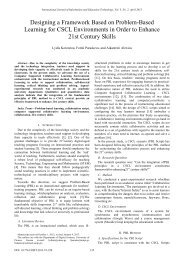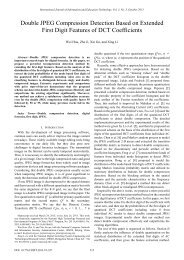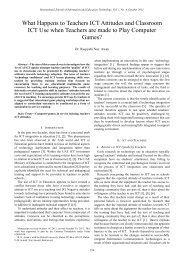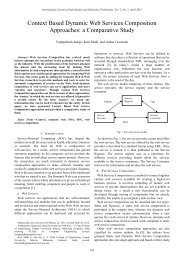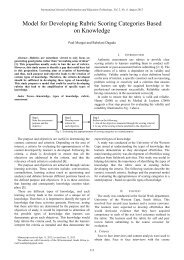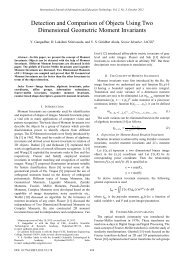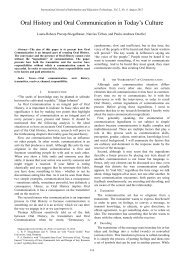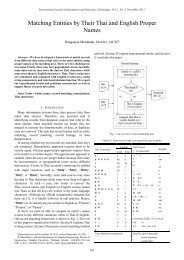Use of Web 2.0 Tools for Teaching Physics in Secondary ... - ijiet
Use of Web 2.0 Tools for Teaching Physics in Secondary ... - ijiet
Use of Web 2.0 Tools for Teaching Physics in Secondary ... - ijiet
Create successful ePaper yourself
Turn your PDF publications into a flip-book with our unique Google optimized e-Paper software.
International Journal <strong>of</strong> In<strong>for</strong>mation and Education Technology, Vol. 3, No. 1, February 2013<strong>Use</strong> <strong>of</strong> <strong>Web</strong> <strong>2.0</strong> <strong>Tools</strong> <strong>for</strong> <strong>Teach<strong>in</strong>g</strong> <strong>Physics</strong> <strong>in</strong> <strong>Secondary</strong>EducationJohn D. Gar<strong>of</strong>alakis, Eir<strong>in</strong>i V. Lagiou, and Athanasios P. PlessasAbstract—Dur<strong>in</strong>g the last years, many <strong>Web</strong> <strong>2.0</strong> technologiesare adopted <strong>in</strong> various aspects <strong>of</strong> education. We present adetailed study <strong>of</strong> the <strong>in</strong>tegration <strong>of</strong> <strong>Web</strong> <strong>2.0</strong> tools <strong>in</strong> educationand attempt to evaluate their contribution <strong>in</strong> the educationalprocess. For the assessment <strong>of</strong> the suitability and effectiveness<strong>of</strong> web <strong>2.0</strong> tools <strong>in</strong> education, we have designed, implemented,and evaluated a pilot case study <strong>for</strong> <strong>Secondary</strong> Education.Specifically, the study presents the application <strong>of</strong> a Learn<strong>in</strong>gManagement System (LMS), called e<strong>Physics</strong> that comb<strong>in</strong>es<strong>Web</strong> <strong>2.0</strong> tools such as Blog, Wiki, Social Bookmark<strong>in</strong>g etc. <strong>for</strong>teach<strong>in</strong>g physics <strong>in</strong> secondary education.This implementation was applied <strong>in</strong> an authentic educationalactivity <strong>in</strong> order to support the collaboration between students.The results <strong>of</strong> this study show that, under appropriate plann<strong>in</strong>g,<strong>Web</strong> <strong>2.0</strong> tools can be used with great success to support realeducational activities and provide a very flexible and efficient<strong>for</strong>m <strong>of</strong> collaborative learn<strong>in</strong>g <strong>in</strong> <strong>Secondary</strong> Education.Index Terms—E-learn<strong>in</strong>g, learn<strong>in</strong>g plat<strong>for</strong>ms, secondaryeducation, teach<strong>in</strong>g tools, web <strong>2.0</strong>.I. INTRODUCTIONWith the <strong>in</strong>tegration <strong>of</strong> In<strong>for</strong>mation and CommunicationTechnologies (ICT) <strong>in</strong> education, a grow<strong>in</strong>g <strong>in</strong>terest is<strong>in</strong>dicated <strong>in</strong> the educational use <strong>of</strong> the World Wide <strong>Web</strong>,implement<strong>in</strong>g activities that support collaborative learn<strong>in</strong>g[1]. Learn<strong>in</strong>g by conditions <strong>of</strong> cooperation has been proposedby many educators (Piaget, Vygotsky etc). Dur<strong>in</strong>g the<strong>in</strong>teraction <strong>of</strong> students different cognitive experiences,attitudes and perceptions are manifested <strong>in</strong> the group,<strong>of</strong>fer<strong>in</strong>g its members a rich socio-cognitive environment thatworks both ways to and from each student - team member [2],[3]. Cooperation with the use <strong>of</strong> the computer and thecollective work with computer are terms <strong>in</strong>troduced <strong>for</strong> thedescription <strong>of</strong> collaborative learn<strong>in</strong>g processes through theuse <strong>of</strong> ICT. Learn<strong>in</strong>g collaborative systems are systems thatare designed primarily <strong>for</strong> students to enable and supportcooperation at a distance via the Internet dur<strong>in</strong>g uni<strong>for</strong>mactivities, such as composition <strong>of</strong> texts, data analysis, etc [4].This work focuses on study<strong>in</strong>g the impact <strong>of</strong> <strong>Web</strong> <strong>2.0</strong> <strong>in</strong>education and the degree <strong>of</strong> effectiveness <strong>in</strong> the enhanc<strong>in</strong>g <strong>of</strong>learn<strong>in</strong>g. The tools <strong>of</strong>fered by <strong>Web</strong> <strong>2.0</strong> are able tocomplement and enrich the educational process and, moreManuscript received September 14, 2012; revised December 12, 2012.J. D. Gar<strong>of</strong>alakis and A. P. Plessas are with the Department <strong>of</strong> ComputerEng<strong>in</strong>eer<strong>in</strong>g and In<strong>for</strong>matics, University <strong>of</strong> Patras, Greece and with theComputer Technology Institute, Patras, Greece (e-mail :gar<strong>of</strong>ala@ceid.upatras.gr, plessas@ceid.upatras.gr)E. V. Lagiou was with the Interdepartmental Course <strong>of</strong> PostgraduateStudies <strong>in</strong> “Electronics and In<strong>for</strong>mation Process<strong>in</strong>g” at the University <strong>of</strong>Patras, Greece. She is now with the Department <strong>of</strong> Computer Eng<strong>in</strong>eer<strong>in</strong>gand In<strong>for</strong>matics, University <strong>of</strong> Patras, Greece (e-mail: eilagiou@upatras.gr).generally, to add to it new <strong>in</strong>terest<strong>in</strong>g collaborativedimensions [5]. <strong>Web</strong> <strong>2.0</strong> technologies such as blogs, wikis,podcasts, social bookmark<strong>in</strong>g, RSS feeds and social networksare generally referred to as "social s<strong>of</strong>tware" and allow usersto develop collaborative content and to notify the public [6].The multiplicity <strong>of</strong> modes <strong>of</strong> <strong>in</strong>troduction and <strong>in</strong>tegration<strong>of</strong> ICT <strong>in</strong> the educational process and especially the variouscategories <strong>of</strong> educational s<strong>of</strong>tware must be considered fromthe perspective <strong>of</strong> different theories and models <strong>of</strong> humanknowledge and learn<strong>in</strong>g. In this context, there are three ma<strong>in</strong>psychological theories that <strong>in</strong>fluenced and <strong>in</strong>fluence thedevelopment <strong>of</strong> educational s<strong>of</strong>tware and there<strong>for</strong>e theposition <strong>of</strong> ICT <strong>in</strong> the teach<strong>in</strong>g and learn<strong>in</strong>g process:• The behaviorism which ma<strong>in</strong>ta<strong>in</strong>s that there is noaccess to the mental states <strong>of</strong> students so the onlyimportant th<strong>in</strong>g to do is to describe the behavior and notto expla<strong>in</strong> it.• The constructivism that focuses <strong>in</strong>side the cognitivesystem, especially on the structure and function.Learn<strong>in</strong>g <strong>in</strong> this context is to modify knowledge andthere<strong>for</strong>e it directly depends on prior knowledge [7].• Socio-cultural approaches, whose fundamentalassumption is that when a person participates <strong>in</strong> a socialsystem, the culture <strong>of</strong> this system and the tools used <strong>for</strong>communication <strong>for</strong>m his/her own sensibleness andconstitute a source <strong>of</strong> learn<strong>in</strong>g and evolution [8].However it should be emphasized that many educationalapplications us<strong>in</strong>g ICT are ma<strong>in</strong>ly designed and led by theadvancement <strong>of</strong> technology rather than the progress achieved<strong>in</strong> the psychology <strong>of</strong> learn<strong>in</strong>g.The objective <strong>of</strong> this research was to <strong>in</strong>vestigate to whatextent the use <strong>of</strong> <strong>Web</strong> <strong>2.0</strong> tools can be used to enhancelearn<strong>in</strong>g through the cooperation and communication amongstudents with the common goal <strong>of</strong> complet<strong>in</strong>g a task. Also,the aim <strong>of</strong> the activity was to export quality results on thecommunication <strong>of</strong> students through an educational plat<strong>for</strong>m.It is studied whether a blog can support and enhance thecommunication and collaboration <strong>of</strong> students <strong>in</strong>side andoutside class, as well as the other tools <strong>in</strong>cluded.The research was carried out <strong>in</strong> the Experimental highschool <strong>of</strong> the University <strong>of</strong> Patras, <strong>in</strong> the first class <strong>of</strong> highschool students <strong>for</strong> the lesson <strong>of</strong> physics.Despite the <strong>in</strong>terest on web <strong>2.0</strong> tools, there is a significantgap <strong>in</strong> the literature regard<strong>in</strong>g their application <strong>in</strong> education.In general, research works show that effective <strong>in</strong>tegration <strong>of</strong>tools <strong>in</strong> the learn<strong>in</strong>g process would require a radical redesign<strong>of</strong> the course and support from students (e.g. <strong>for</strong> wikis[9]-[10]). More specifically, the previous studies show thatthe use <strong>of</strong> web <strong>2.0</strong> tools (e.g. blogs, wikis, etc) by students <strong>in</strong>the course is small. Furthermore, we would like to emphasizethat there are different effects <strong>for</strong> achiev<strong>in</strong>g cooperation withthe use <strong>of</strong> tools, <strong>for</strong> example <strong>in</strong> the case <strong>of</strong> wiki theDOI: 10.7763/IJIET.2013.V3.2246
International Journal <strong>of</strong> In<strong>for</strong>mation and Education Technology, Vol. 3, No. 1, February 2013collaboration between students is limited [11], while <strong>in</strong> thecase <strong>of</strong> blog students are <strong>in</strong> favor <strong>of</strong> the cont<strong>in</strong>ued use <strong>of</strong>blogs as an effective aid to teach<strong>in</strong>g and learn<strong>in</strong>g [12].The research has been limited to the use <strong>of</strong> a s<strong>in</strong>gle web <strong>2.0</strong>tool (and not the comb<strong>in</strong>ation <strong>of</strong> different tools) and mostapplications concern higher education rather than secondaryeducation. This is the reason why we decided to use oneplat<strong>for</strong>m which comb<strong>in</strong>es more tools use it <strong>in</strong> <strong>Secondary</strong>Education.II. EPHYSICSThe Open eClass plat<strong>for</strong>m is a complete Learn<strong>in</strong>gManagement System (LMS). It is the solution <strong>of</strong>fered by theGreek Academic Network GUnet to support AsynchronouseLearn<strong>in</strong>g Services.The teacher can use it <strong>in</strong> cooperation with the students whoare organized <strong>in</strong> groups to share <strong>in</strong><strong>for</strong>mation, updates,learn<strong>in</strong>g material, task assignments and communicatethrough the tools provided. Moreover, the teacher canorganize groups <strong>of</strong> parents to communicate with them and tolook <strong>for</strong> other educators engaged <strong>in</strong> the respective plat<strong>for</strong>m.The course covered <strong>Physics</strong> <strong>for</strong> the first grade <strong>of</strong> highschool. The educational scenario was created after carefulstudy and plann<strong>in</strong>g. In the application, the follow<strong>in</strong>g tools –subsystems have been selected:• Wiki: it consists a dictionary with def<strong>in</strong>itions <strong>of</strong> theconcepts used <strong>in</strong> this physics lesson. Students milled thecorrespond<strong>in</strong>g texts that have already been entered <strong>for</strong>each chapter.• Blog: there were four entries, two <strong>for</strong> physics, one <strong>for</strong>the scientific Workshop held <strong>in</strong> The ExperimentalSchool, and f<strong>in</strong>ally one <strong>for</strong> the Day <strong>of</strong> museums.• L<strong>in</strong>ks: bookmark<strong>in</strong>g enables access to useful onl<strong>in</strong>eresources grouped <strong>in</strong>to categories related to the lesson.• Telecooperation: this tool <strong>in</strong>cludes the functionality <strong>of</strong>text messag<strong>in</strong>g.• E-book: an e-book identical to the pr<strong>in</strong>ted book studentsare us<strong>in</strong>g.• Exercises: self-assessment exercises (true or false type,multiple choices) <strong>for</strong> four chapters have been published.• Announcements: a message board <strong>for</strong> <strong>in</strong><strong>for</strong>m<strong>in</strong>gstudents about important announcements.• Agenda: a calendar with the announced presentations <strong>of</strong>the plat<strong>for</strong>m.• Documents: posted onl<strong>in</strong>e, the usage <strong>in</strong>structions <strong>of</strong> theplat<strong>for</strong>m and the educational material the students hadto study <strong>for</strong> the f<strong>in</strong>al exams.• Questionnaire: the questionnaire that was used at theend <strong>of</strong> the process and the students could completeelectronically.III. PROCESS OF EVALUATIONAs it has already been mentioned, the research wasconducted at the Experimental Lyceum <strong>of</strong> the University <strong>of</strong>Patras <strong>in</strong> the first grade <strong>for</strong> the lesson <strong>of</strong> physics. The classhad 20 students, but <strong>in</strong> the research participated 10. Theparticipation was only 50% because (as the students said)they don’t have time to <strong>in</strong>clude it <strong>in</strong> their daily life as theyfocused on study<strong>in</strong>g <strong>for</strong> the exams. Another reason was (<strong>in</strong>our op<strong>in</strong>ion) that the students were accustomed to us<strong>in</strong>ganother similar plat<strong>for</strong>m dur<strong>in</strong>g the school year and didn’twant to deal with someth<strong>in</strong>g else.Two school hours (45 m<strong>in</strong>utes each) were used:• Dur<strong>in</strong>g the first hour, as shown <strong>in</strong> the description <strong>of</strong> theeducational scenario, the use <strong>of</strong> the plat<strong>for</strong>m and itssubsystems was expla<strong>in</strong>ed, with a short presentationwith a projector <strong>in</strong> the <strong>Physics</strong> lab. (Phases 1 and 2)• Dur<strong>in</strong>g the second hour, there was a discussion with thestudents, to express their op<strong>in</strong>ion about the plat<strong>for</strong>m andsuggestions <strong>for</strong> improvement. (Phase 3)Description <strong>of</strong> the phases <strong>of</strong> the preparation andimplementation <strong>of</strong> educational scenario.Preparation: Each student should have access to the<strong>in</strong>ternet and an account <strong>in</strong> e<strong>Physics</strong> (given to them). Afterdeal<strong>in</strong>g with the onl<strong>in</strong>e course, they had to respond to theelectronic questionnaire <strong>for</strong> assess<strong>in</strong>g e<strong>Physics</strong>, certa<strong>in</strong>lyafter hav<strong>in</strong>g used it.• Phase 1: Introduction - Presentation <strong>of</strong> e<strong>Physics</strong>: Briefpresentation by the teacher to <strong>in</strong>troduce students to theplat<strong>for</strong>m and its use <strong>in</strong>side and outside the classroom.• Phase 2: Us<strong>in</strong>g e<strong>Physics</strong>: The teacher with a briefpresentation demonstrates the ease <strong>of</strong> use e<strong>Physics</strong> <strong>for</strong><strong>in</strong>troduc<strong>in</strong>g students to the plat<strong>for</strong>m. Demonstrat<strong>in</strong>g theplat<strong>for</strong>m and tools.• Phase 3: Discussion - Conclusions: After thepresentation by the teacher, a discussion is developedabout the advantages and disadvantages <strong>of</strong> us<strong>in</strong>ge<strong>Physics</strong> <strong>in</strong> class and students are <strong>in</strong>vited to submit theirexperiences.• Phase 4: Questionnaire Answer: After us<strong>in</strong>g e<strong>Physics</strong>,the students are <strong>in</strong>vited to respond to the electronicquestionnaire <strong>for</strong> the evaluation <strong>of</strong> the plat<strong>for</strong>m.A. Target SkillsAfter the end <strong>of</strong> the tra<strong>in</strong><strong>in</strong>g scenario, the students wereexpected to be able to use the e<strong>Physics</strong> as well as any similarplat<strong>for</strong>m <strong>of</strong> Asynchronous eLearn<strong>in</strong>g. After hav<strong>in</strong>gunderstood the use <strong>of</strong> web <strong>2.0</strong> tools, they were expected tocomment on Blogs, publish and edit text <strong>in</strong> the Wiki andother similar type tools with clear-th<strong>in</strong>k<strong>in</strong>g and correct use, tosearch <strong>for</strong> onl<strong>in</strong>e multimedia material related to the lesson, tocooperate and mutually assist each other.B. Objective AttitudesAfter us<strong>in</strong>g this plat<strong>for</strong>m <strong>of</strong> asynchronous learn<strong>in</strong>g,students were expected to understand the advantages anddisadvantages <strong>of</strong> the use <strong>of</strong> <strong>in</strong>novative onl<strong>in</strong>e tools, such asweb <strong>2.0</strong> tools to publish the results <strong>of</strong> their <strong>in</strong>tellectual work.They were also expected to comment on the blog withconscience, not to delete unnecessarily and withoutdocumentation content from the wiki pages and also torespect the <strong>in</strong>tellectual work <strong>of</strong> others, <strong>in</strong>clud<strong>in</strong>g theirclassmates.C. The ResultsClassroom observation and discussion with studentsdemonstrates that the web <strong>2.0</strong> tools are acceptable, s<strong>in</strong>ce themajority <strong>of</strong> the students expressed their desire to be able touse the plat<strong>for</strong>m from the beg<strong>in</strong>n<strong>in</strong>g <strong>of</strong> the school year, as akey tool <strong>for</strong> the classroom <strong>in</strong> <strong>Physics</strong> and other lessons.To evaluate the activity, the students answered an onl<strong>in</strong>equestionnaire <strong>in</strong> order to extract additional conclusions.Overall, the pilot study <strong>in</strong>cludes a sample <strong>of</strong> 10 students7
International Journal <strong>of</strong> In<strong>for</strong>mation and Education Technology, Vol. 3, No. 1, February 2013who were <strong>in</strong>volved with the application and responded to thequestionnaire, <strong>of</strong> whom 5 were male (50%) and 5 werefemale (50%).respective question as shown <strong>in</strong> Fig. 5.Fig. 1. GenderFig. 4. The subsystem <strong>of</strong> wiki helped me understand the usefulness <strong>of</strong> thewiki on the webInitially, it should be noted that all students have had someexperience with relevant e-learn<strong>in</strong>g plat<strong>for</strong>ms. Specifically,50% <strong>of</strong> students had much or fairly experience while theother 50% were students who had little or m<strong>in</strong>imumexperience (Fig. 2).Fig. 5. The ability <strong>of</strong> wiki to keep history <strong>of</strong> changes I th<strong>in</strong>k that helps andprovide confidence and security.Still, the overwhelm<strong>in</strong>g majority <strong>of</strong> students (90%) believethat the structure <strong>of</strong> a blog helps them express their op<strong>in</strong>ions,while a large proportion (70%) understood the usefulness <strong>of</strong>blogs through the application.Fig. 2. Be<strong>for</strong>e us<strong>in</strong>g e<strong>Physics</strong>, I had previous experience with similarplat<strong>for</strong>ms.For this reason, all students confirm the ease <strong>of</strong> learn<strong>in</strong>gand handl<strong>in</strong>g e<strong>Physics</strong>. Another expected result is that moststudents said they did not need much support to use e<strong>Physics</strong>and <strong>in</strong> total the structure <strong>of</strong> the navigation and <strong>in</strong><strong>for</strong>mationwas appropriate and comprehensible (Fig. 3).Fig. 6. The structure <strong>of</strong> blog helps me to tell my op<strong>in</strong>ion on issues related tothe lesson.Fig. 3. As a new user, I did not need much support to use this collaborativeenvironment.There were also questions concern<strong>in</strong>g the tools <strong>in</strong> order toevaluate their use. The results <strong>of</strong> the research <strong>in</strong>dicate that themajority <strong>of</strong> students did not know how to use the wiki andwhat the advantages <strong>of</strong> this tool are and e<strong>Physics</strong> helped themto understand it (Fig. 4).Furthermore, the ability <strong>of</strong> the Wiki to record revisionhistory did not impress the students, s<strong>in</strong>ce only 50% believethat it <strong>of</strong>fers confidence and security. It is worth not<strong>in</strong>g that a30% <strong>of</strong> the students gave the answer “Neutral” to theFig. 7. I would like to be able to use the plat<strong>for</strong>m to the other courses.Concern<strong>in</strong>g other tools, such as bookmark<strong>in</strong>g andtelecooperation, the result <strong>for</strong> bookmark<strong>in</strong>g is entirelypositive, while <strong>for</strong> telecooperation a high proportion <strong>of</strong>students were undecided s<strong>in</strong>ce they answered neutral.F<strong>in</strong>ally, another <strong>in</strong>terest<strong>in</strong>g result was that 100% <strong>of</strong>students would like to use a similar application with e<strong>Physics</strong>and <strong>in</strong> the rest <strong>of</strong> the subjects because they f<strong>in</strong>d it fun, easyand an important tool <strong>for</strong> the school.8
International Journal <strong>of</strong> In<strong>for</strong>mation and Education Technology, Vol. 3, No. 1, February 2013The students generally expressed positive comments aboute<strong>Physics</strong> and <strong>in</strong>dicated that they would like to have access toit, from the beg<strong>in</strong>n<strong>in</strong>g <strong>of</strong> the school year.Fig. 8. The e<strong>Physics</strong> are pleasant and easy to use and I consider is animportant tool <strong>in</strong> school.IV. CONCLUSIONThis work was designed to present <strong>Web</strong> <strong>2.0</strong> tools <strong>in</strong> theclassroom and to study closely their use <strong>in</strong> the educationalprocess. That's why the asynchronous eLearn<strong>in</strong>g plat<strong>for</strong>mOpen eClass was chosen, which comb<strong>in</strong>es this type <strong>of</strong> tools.The ma<strong>in</strong> aim was also to provide research evidence anddraw conclusions about how effective the use <strong>of</strong> <strong>Web</strong> <strong>2.0</strong>tools can be.The study, presented an application, e<strong>Physics</strong>, which wasused to support the collaboration <strong>of</strong> students <strong>in</strong> a course <strong>of</strong>physics. It was used more like a repetition <strong>for</strong> the students,s<strong>in</strong>ce the period presented was the repetition period <strong>for</strong> thef<strong>in</strong>al exams. The research raised several and <strong>in</strong>terest<strong>in</strong>gresults, which are presented <strong>in</strong> detail <strong>in</strong> the previous section.A basic conclusion that is worth mention<strong>in</strong>g is theenthusiasm <strong>of</strong> the students and the dedication they have tolearn more about these tools and their targeted queries. Theresults from the questionnaire were generally encourag<strong>in</strong>g.The total <strong>of</strong> the responses showed that the students were <strong>in</strong>favor <strong>of</strong> us<strong>in</strong>g the tools <strong>in</strong> the classroom and few responseswere neutral or negative. These responses lead us to theconclusion that there is positive contribution <strong>of</strong> participatoryweb tools <strong>in</strong> education.For future work we <strong>in</strong>tend to <strong>in</strong>troduce such a plat<strong>for</strong>mfrom the beg<strong>in</strong>n<strong>in</strong>g <strong>of</strong> the school year <strong>in</strong> order to assessstudent’s communication through web <strong>2.0</strong> tools <strong>for</strong> a longperiod <strong>of</strong> time. In this research, we did not have muchapplication time s<strong>in</strong>ce the exams were approach<strong>in</strong>g. Thelesson should be designed and organized <strong>in</strong> such a way as toall the tools cover all the course contents.With<strong>in</strong> such a framework, we could <strong>in</strong>tegrate the blog andother web <strong>2.0</strong> tools as a means <strong>of</strong> exchang<strong>in</strong>g ideas andsupport <strong>for</strong> remote collaboration and communicationbetween students, as well as the expansion <strong>of</strong> school time andspace.REFERENCES[1] Ν. Selwyn. (2008). Education <strong>2.0</strong>? Design<strong>in</strong>g the <strong>Web</strong> <strong>for</strong> teach<strong>in</strong>g andlearn<strong>in</strong>g. [Onl<strong>in</strong>e]. Available:http://www.tlrp.org/pub/documents/TELcomm.pdf[2] J. Piaget, “The essential Piaget,” Basic Books, Inc. New York, 1977.[3] L. Vygotsky, M<strong>in</strong>d and Society: The Development <strong>of</strong> Higher MentalProcesses, Harvard University Press, Cambridge, 1978.[4] A. U. Kusware, A. Cram, and D. Richards, “<strong>Web</strong> <strong>2.0</strong> supportedcollaborative learn<strong>in</strong>g activities: Towards an af<strong>for</strong>dance perspective,”<strong>in</strong> Proceed<strong>in</strong>gs <strong>of</strong> the 3rd International LAMS and Learn<strong>in</strong>g DesignConference, 2008.[5] J. Preece, Onl<strong>in</strong>e Communities: Design<strong>in</strong>g Usability, Support<strong>in</strong>gSociability, Wiley, Chichester, U K, 2000.[6] W. Richardson, Blogs, Wikis, Podcasts and Other Powerful <strong>Web</strong> tools<strong>for</strong> Classrooms, Third Edition, Corw<strong>in</strong> Publications, 2010.[7] D. H. Jonassen, K. L. Peck, and B. G. Wilson, “Learn<strong>in</strong>g withtechnology : a constructivist perspective,” Upper Saddle River, N. J.:Merrill, 1999.[8] M. C. Pettenati and M. E. Cigogn<strong>in</strong>i, “Social Network<strong>in</strong>g Theories and<strong>Tools</strong> to Support Connectivist Learn<strong>in</strong>g Activities,” InternationalJournal <strong>of</strong> <strong>Web</strong>-Based Learn<strong>in</strong>g and <strong>Teach<strong>in</strong>g</strong> Technologies, vol. 2, no.3, pp. 39-57, July-September 2007.[9] M. Cole, “Us<strong>in</strong>g Wiki technology to support student engagement:Lessons from the trenches,” Computers & Education, vol. 52, no. 1, pp.141-146, 2008.[10] G. Ravid, Y. M. Kalman, and S. Rafaeli, “Wikibooks <strong>in</strong> highereducation: Empowerment through on-l<strong>in</strong>e distributed collaboration,”Computers <strong>in</strong> Human Behavior, vol. 24, no. 5, pp. 1913–1928, 2008.[11] W. W.-K. Ma and A. H. K. Yuen, “A qualitative analysis oncollaborative learn<strong>in</strong>g experience <strong>of</strong> student journalists us<strong>in</strong>g wiki,” J.Fong, Reggie, K. Wang, W. F. Lee, (eds.), “Hybrid Learn<strong>in</strong>g andEducation,” <strong>in</strong> Proceed<strong>in</strong>gs <strong>of</strong> the first International Conference onHybrid Learn<strong>in</strong>g, Berl<strong>in</strong>: Spr<strong>in</strong>ger-Verlag, 2008, pp. 103-114.[12] J. B. Williams and J. Jacobs, “Explor<strong>in</strong>g the use <strong>of</strong> blogs as learn<strong>in</strong>gspaces <strong>in</strong> the higher education sector,” Australasian Journal <strong>of</strong>Educational Technology, 2004, vol. 20, no. 2, pp. 232-247.John D. Gar<strong>of</strong>alakis was born <strong>in</strong> 1959, <strong>in</strong> NewZealand. He has completed his postgraduate studies atthe School <strong>of</strong> Electrical and Computer Eng<strong>in</strong>eer<strong>in</strong>g atNational Technical University <strong>of</strong> Athens, Greece(1983). He received his Ph.D <strong>in</strong> ComputerEng<strong>in</strong>eer<strong>in</strong>g and In<strong>for</strong>matics at University <strong>of</strong> Patras,Greece (1990).Now, he is Pr<strong>of</strong>essor at the Department <strong>of</strong> Computer Eng<strong>in</strong>eer<strong>in</strong>g andIn<strong>for</strong>matics, University <strong>of</strong> Patras, Greece, and Director <strong>of</strong> the appliedresearch department “Telematics Center”, <strong>of</strong> the Research AcademicComputer Technology Institute and Press. Also, he is Coord<strong>in</strong>ator <strong>of</strong> theThematic Unit “Telematics, Internet and Society” <strong>of</strong> the Hellenic OpenUniversity.Pr<strong>of</strong>. Gar<strong>of</strong>alakis is responsible and scientific coord<strong>in</strong>ator <strong>of</strong> severalrecent European and national IT and Telematics Projects (ICT, INTERREG,etc.). His publications <strong>in</strong>clude more than 130 articles <strong>in</strong> refereedInternational Journals and Conferences. His research <strong>in</strong>terests <strong>in</strong>clude <strong>Web</strong>and Mobile Technologies, Per<strong>for</strong>mance Analysis <strong>of</strong> Computer Systems,Computer Networks and Telematics, Distributed Computer Systems,Queu<strong>in</strong>g Theory. http://athos.cti.gr/gar<strong>of</strong>alakis/<strong>in</strong>dex_en.htmEir<strong>in</strong>i V. Lagiou was born <strong>in</strong> 1987, <strong>in</strong> Athens,Greece. She completed her postgraduate studies <strong>in</strong>the Department <strong>of</strong> <strong>Physics</strong> at the University <strong>of</strong>Ioann<strong>in</strong>a, Greece (2005-2010). Then, cont<strong>in</strong>uedher M.Sc. studies at the Interdepartmental Course<strong>of</strong> Postgraduate Studies <strong>in</strong> “Electronics andIn<strong>for</strong>mation Process<strong>in</strong>g” at the University <strong>of</strong>Patras (2010-2012). Now, she is a PhD candidate<strong>of</strong> the Department <strong>of</strong> Computer Eng<strong>in</strong>eer<strong>in</strong>g andIn<strong>for</strong>matics at University <strong>of</strong> Patras, Greece.Her ma<strong>in</strong> research <strong>in</strong>terests <strong>in</strong>clude the <strong>in</strong>tegration and evaluation <strong>of</strong>In<strong>for</strong>mation and Communication Technologies <strong>in</strong> Education, the use <strong>of</strong> <strong>Web</strong><strong>2.0</strong> tools <strong>in</strong> Education and Mobile Learn<strong>in</strong>g.Athanasios P. Plessas was born <strong>in</strong> 1982, <strong>in</strong> Pyrgos,Greece. He has completed his postgraduate studies atthe Computer Eng<strong>in</strong>eer<strong>in</strong>g and In<strong>for</strong>maticsDepartment, University <strong>of</strong> Patras <strong>in</strong> 2005. Hereceived a M.Sc. <strong>in</strong> Computer Science andTechnology from the same university <strong>in</strong> 2008. He iscurrently a PhD candidate <strong>of</strong> the Department <strong>of</strong>Computer Eng<strong>in</strong>eer<strong>in</strong>g and In<strong>for</strong>matics <strong>of</strong> theUniversity <strong>of</strong> Patras.He currently work as an external partner <strong>for</strong> the Computer TechnologyInstitute and Press. He has several publications <strong>in</strong> <strong>in</strong>ternational and nationalconferences. His research <strong>in</strong>terests <strong>in</strong>clude ubiquitous and pervasivecomput<strong>in</strong>g and the use <strong>of</strong> ICT <strong>in</strong> education9



